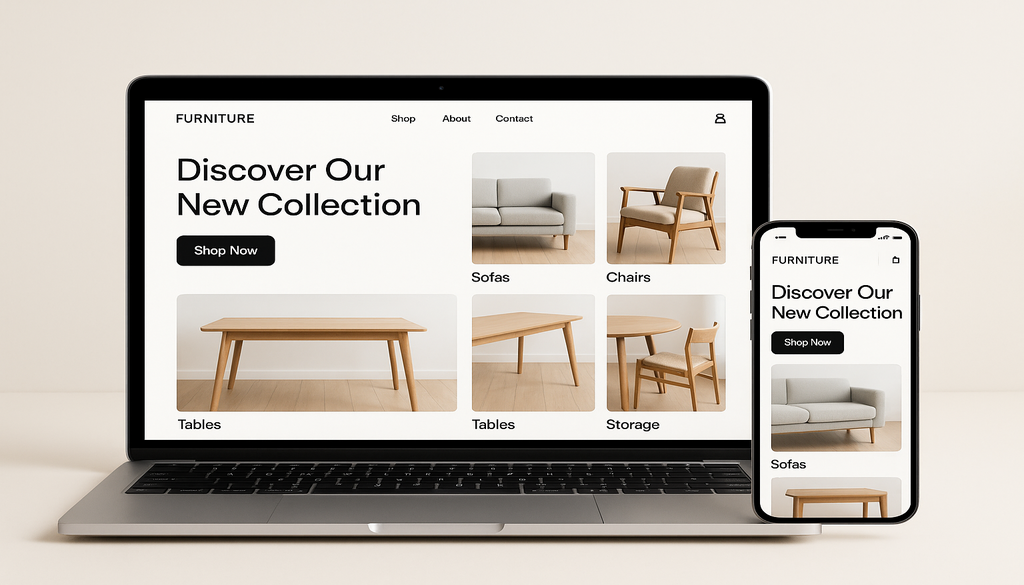Essential Tips for Successfully Selling Furniture Online in 2025
Understanding the Online Furniture Market in 2025
The online furniture market in 2025 is poised for significant growth, driven by evolving consumer behaviors and technological advancements. As more consumers embrace online shopping, the demand for furniture e-commerce platforms continues to rise. According to a recent study, the global online furniture market is expected to reach $112 billion by 2025, with a compound annual growth rate (CAGR) of 10%. This growth is fueled by the increasing preference for convenience, a wider selection of products, and competitive pricing offered by online retailers.
Technology plays a pivotal role in shaping the online furniture market. Innovations such as augmented reality (AR) and virtual reality (VR) are transforming the way consumers interact with products. These technologies allow customers to visualize furniture in their own spaces, enhancing the shopping experience and reducing the likelihood of returns. Additionally, data analytics and artificial intelligence (AI) enable retailers to personalize marketing strategies, optimize inventory management, and improve customer service, thereby driving sales and customer satisfaction.
Developing a User-Friendly Furniture E-commerce Website

Creating a user-friendly e-commerce website is essential for success in the online furniture market. A well-designed website not only attracts potential customers but also enhances their shopping experience, leading to higher conversion rates. Key features of a successful online furniture store include intuitive navigation, fast loading times, and a seamless checkout process. These elements ensure that customers can easily find and purchase the products they desire without unnecessary friction.
Mobile optimization is another critical aspect of a user-friendly website. With over 50% of online shopping conducted on mobile devices, ensuring that your website is responsive and mobile-friendly is paramount. A mobile-optimized site provides a consistent and enjoyable experience across all devices, increasing the likelihood of conversions. Additionally, incorporating user experience (UX) design principles, such as clear calls-to-action, easy-to-read fonts, and visually appealing layouts, can further enhance the overall shopping experience.
High-Quality Product Photography and Descriptions
In the competitive world of online furniture sales, high-quality product photography and compelling descriptions are crucial for attracting and converting customers. Capturing visually appealing images of your furniture is essential, as these images serve as the first impression for potential buyers. Invest in professional photography or use high-resolution cameras to showcase your products from multiple angles, highlighting key features and details.
Writing effective product descriptions is equally important. A well-crafted description should provide essential information about the product, including dimensions, materials, and unique features. Additionally, incorporating storytelling elements can help create an emotional connection with potential buyers. For example, describing how a particular piece of furniture can enhance the ambiance of a room or improve functionality can make the product more appealing. Remember to use relevant keywords naturally within your descriptions to improve search engine visibility and attract more traffic to your site.
Leveraging Social Media and Digital Marketing

Social media and digital marketing are powerful tools for reaching and engaging with potential customers in the online furniture market. Platforms like Instagram, Pinterest, and Facebook are particularly effective for furniture sellers, as they allow for visual storytelling and direct interaction with consumers. By sharing high-quality images, videos, and user-generated content, you can showcase your products and build a loyal community around your brand.
Implementing effective social media strategies involves understanding your target audience and tailoring your content to their preferences. For instance, using Instagram Stories to provide behind-the-scenes looks at your design process or hosting live Q&A sessions can foster a sense of connection and trust with your audience. Additionally, leveraging influencer partnerships and paid advertising can expand your reach and attract new customers.
SEO is another critical component of digital marketing for furniture sellers. By optimizing your website and content for relevant keywords, you can increase your visibility in search engine results and drive organic traffic to your site. Key strategies include optimizing product titles and descriptions, creating informative blog posts, and building backlinks from reputable sources. These efforts not only improve your search rankings but also establish your brand as an authority in the furniture industry.
Streamlining Logistics for Online Furniture Sales
Efficient logistics are essential for the success of online furniture sales, as they directly impact customer satisfaction and retention. Shipping large and bulky items like furniture presents unique challenges, such as high shipping costs and potential damage during transit. To overcome these challenges, it’s crucial to partner with reliable logistics providers who specialize in handling furniture deliveries.
Choosing the right logistics partners involves evaluating their experience, reputation, and technology capabilities. Look for providers that offer real-time tracking, flexible delivery options, and robust customer support. Additionally, consider implementing technology solutions such as warehouse management systems (WMS) and transportation management systems (TMS) to streamline your operations and improve efficiency. These tools can help optimize inventory management, reduce shipping errors, and enhance overall customer satisfaction.
Customer Service and Support in the Digital Age

In the digital age, providing exceptional customer service is vital for building trust and loyalty with your customers. As online interactions replace face-to-face communication, it’s essential to offer multiple channels for customer support, such as live chat, email, and social media. These channels allow customers to reach out with questions or concerns, ensuring a seamless shopping experience.
Utilizing technology to enhance customer interactions can further improve service quality. For example, implementing AI-powered chatbots can provide instant responses to common inquiries, freeing up human agents to handle more complex issues. Additionally, using customer relationship management (CRM) systems can help track interactions and personalize communication, leading to more meaningful and effective customer service.
Building trust with your customers also involves being transparent and responsive. Clearly communicate your return policies, shipping timelines, and any potential delays. By setting realistic expectations and promptly addressing customer concerns, you can foster a positive reputation and encourage repeat business.
Conclusion
In conclusion, successfully selling furniture online in 2025 requires a comprehensive approach that encompasses user-friendly website design, high-quality product presentation, effective digital marketing, streamlined logistics, and exceptional customer service. By focusing on these key areas, furniture retailers can navigate the competitive e-commerce landscape and achieve sustainable growth. As technology continues to evolve, staying informed and adaptable will be crucial for maintaining a competitive edge. Embrace these strategies to enhance your online furniture business and meet the demands of the modern consumer.
Frequently Asked Questions (FAQ)
Q1: What are the most effective platforms for selling furniture online in 2025?
A1: While traditional platforms like Amazon and eBay remain popular, niche marketplaces and dedicated e-commerce websites are increasingly effective due to targeted audiences. Platforms such as Wayfair and Houzz offer specialized environments for furniture sales, attracting customers specifically interested in home furnishings.
Q2: How can I differentiate my furniture offerings in a saturated online market?
A2: Focus on unique design elements, sustainable materials, and exceptional customer service to stand out. Highlighting eco-friendly practices and customizable options can also appeal to conscientious consumers. Additionally, engaging storytelling and branding can create a distinct identity that resonates with your target audience.
Q3: What are the common pitfalls in online furniture sales and how can I avoid them?
A3: Common issues include poor website design, inadequate product descriptions, and logistics challenges. Investing in quality website design, detailed product information, and reliable shipping services can mitigate these risks. Regularly updating your website and staying informed about industry trends can also help you avoid potential pitfalls.
Q4: How important is SEO for selling furniture online and what are some key strategies?
A4: SEO is crucial for visibility. Use targeted keywords, optimize product descriptions, and engage in content marketing to boost your search engine rankings. Additionally, leveraging local SEO strategies and optimizing for voice search can further enhance your online presence and attract more customers.
Q5: Can augmented reality (AR) help in selling furniture online? How?
A5: Yes, AR can significantly enhance the online shopping experience by allowing customers to visualize furniture in their own space, potentially reducing return rates and increasing satisfaction. By integrating AR technology into your website or app, you can offer an interactive and immersive experience that helps customers make informed purchasing decisions.
{“@context”:”https://schema.org”,”@type”:”FAQPage”,”mainEntity”:[{“@type”:”Question”,”name”:”What are the most effective platforms for selling furniture online in 2025?”,”acceptedAnswer”:{“@type”:”Answer”,”text”:”While traditional platforms like Amazon and eBay remain popular, niche marketplaces and dedicated e-commerce websites are increasingly effective due to targeted audiences. Platforms such as Wayfair and Houzz offer specialized environments for furniture sales, attracting customers specifically interested in home furnishings.”}},{“@type”:”Question”,”name”:”How can I differentiate my furniture offerings in a saturated online market?”,”acceptedAnswer”:{“@type”:”Answer”,”text”:”Focus on unique design elements, sustainable materials, and exceptional customer service to stand out. Highlighting eco-friendly practices and customizable options can also appeal to conscientious consumers. Additionally, engaging storytelling and branding can create a distinct identity that resonates with your target audience.”}},{“@type”:”Question”,”name”:”What are the common pitfalls in online furniture sales and how can I avoid them?”,”acceptedAnswer”:{“@type”:”Answer”,”text”:”Common issues include poor website design, inadequate product descriptions, and logistics challenges. Investing in quality website design, detailed product information, and reliable shipping services can mitigate these risks. Regularly updating your website and staying informed about industry trends can also help you avoid potential pitfalls.”}},{“@type”:”Question”,”name”:”How important is SEO for selling furniture online and what are some key strategies?”,”acceptedAnswer”:{“@type”:”Answer”,”text”:”SEO is crucial for visibility. Use targeted keywords, optimize product descriptions, and engage in content marketing to boost your search engine rankings. Additionally, leveraging local SEO strategies and optimizing for voice search can further enhance your online presence and attract more customers.”}},{“@type”:”Question”,”name”:”Can augmented reality (AR) help in selling furniture online? How?”,”acceptedAnswer”:{“@type”:”Answer”,”text”:”Yes, AR can significantly enhance the online shopping experience by allowing customers to visualize furniture in their own space, potentially reducing return rates and increasing satisfaction. By integrating AR technology into your website or app, you can offer an interactive and immersive experience that helps customers make informed purchasing decisions.”}}]}










